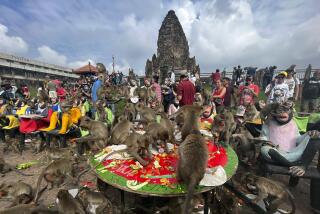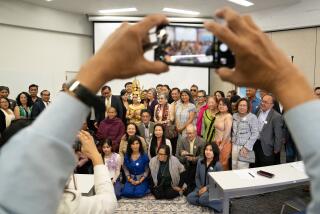A Business You Can Sink Your Teeth Into
- Share via
SIEM REAP, Cambodia — The deal’s a slippery one, no doubt about it, but the profits are impressive: up to 1,350%.
There’s one catch: The business could eat you up, notes Nao Thuok, a government official who promotes raising crocodiles as a sideline for Cambodian farmers.
Raising crocs can be very dangerous, until you learn to recognize the touchy situations, such as when the reptiles are protecting young or are really hungry, notes the official known as “the Crocodile Man.”
After the liberation of Cambodia from the Khmer Rouge’s reign of terror in the 1970s, stories were rife that the radical Marxists fed live humans to the animals at Cambodia’s largest crocodile farm.
The farm is thriving today. And in the surrounding countryside, where decades of war wrought ruin and poverty, more people are enjoying a better life by raising the animals for their skins and meat--sour crocodile soup and croc curry are favorites.
Nao Thuok, deputy director of the Fisheries Department, says more than 400 farms have sprung up across Cambodia, about half of them in this northwestern province of Siem Reap.
Unlike the Siem Reap state-owned farm with its 450 crocs, most are small-scale, with 10 to 20 animals in backyards, sparking jokes about drunks hopping over a wall and landing among a pack of jaws.
Although wild crocodiles are considered endangered, the prospects for growth in the croc farming business look good.
Nao Thuok, who has been breeding crocodiles for 18 years, says Cambodia likely will sign the Convention on the International Trade in Endangered Species this year. The pact allows the regulated export of commercially raised crocodile skins, and he estimates that foreign sales could bring in $20 million.
European and Japanese buyers have already approached the Siem Reap state farm looking for a steady supply of skins, from which handbags, belts, shoes and other items are fashioned.
Even now, skins produced by some private operators are being smuggled to neighboring Thailand and Vietnam. State-owned farms only supply hatchlings and expertise to the smaller entrepreneurs, Nao Thuok says.
After surviving the brutal Khmer Rouge regime, Nao Thuok observed how locals raised crocodiles, spent time on a farm in Cuba and wrote a thesis on the potential of crocodile farming in rural Cambodia. He estimated private farms could earn up to 1,350% on what it costs to raise crocodiles and less efficient state farms could make a third of that.
Sam Rithya, a Siem Reap farmer, says he bought 100 baby crocs for the equivalent of $34 apiece in 1994, and was recently offered more than $30,000 for his operation. The animals, he says, require little space or care, have a low mortality rate and can be fed with cheap fish from the nearby Tonle Sap, Cambodia’s great lake.
While crocodiles live to be as old as 80, the best time for slaughter is at age 3 when they average 5 feet in length. After that, their rate of growth slows and appetites increase.
Cambodia also has the advantage of a wild crocodile population, from which breeding stock can be taken to ensure genetic vitality.
Like all species of Cambodia’s once prolific wildlife, crocodiles have been depleted, but they still can be found in 14 of the country’s 19 provinces. Nao Thuok estimates 10,000 freshwater crocodiles remain in the wild, while the saltwater variety is all but extinct.
He urges individual farmers and the 45-member Crocodile Farming Development Assn. to reintroduce crocodiles into the wild, perhaps 2% to 3% of captive stock each year.
In addition to his position at the Fisheries Department and as director of the Siem Reap crocodile farm, Nao Thuok also keeps about 300 crocs in his own backyard. Family and relatives do most of the work on the home farm.
He says his love for crocodiles goes beyond mere economics. He spends time each day just admiring the formidable beasts at his home and in the well-kept pens of the state farm.
More to Read
Sign up for Essential California
The most important California stories and recommendations in your inbox every morning.
You may occasionally receive promotional content from the Los Angeles Times.










